Vigna parkeri & V. hosei
Tropical Forages
Vigna hosei (Craib) Backer
Vigna parkeri Baker
Subordinate taxa:
Vigna parkeri Baker subsp. acutifoliola Verdc.
Vigna parkeri Baker subsp. maranguënsis (Taub.) Verdc.
Vigna parkeri Baker subsp. parkeri
subsp. maranguënsis: Basionym: Dolichos maranguënsis Taub.; V. maranguënsis (Taub.) Harms
Note: Prior to about 1970, Vigna parkeri Baker subsp. maranguënsis (Taubert) Verdc. accessions were held in the Australian genebank as Vigna gracilis, and should have more correctly been referred to as Vigna gracilis auct., non (Guill. and Perr.) Hook. f.
Vigna hosei: Basionym: Dolichos hosei Craib; Vigna oligosperma Backer, nom. nud.
Note: Verdcourt (1970) observes that Vigna hosei (Craib) Backer is similar to, and possibly comprises Vigna parkeri Baker subsp. acutifoliola Verdc., and part of Vigna parkeri Baker subsp. maranguënsis (Taubert) Verdc. For the purposes of this publication, we have treated Vigna parkeri and Vigna hosei, as separate species, the former more appropriate for the upland tropics and lowland subtropics, and the latter for the lowland wet tropics.
Family: Fabaceae (alt. Leguminosae) subfamily: Faboideae tribe: Phaseoleae subtribe: Phaseolinae subgenus: Vigna.
Vigna parkeri
Perennial mat-forming herb; main stems prostrate, rooting at the nodes; axillary stems climbing to over 1 m in some ecotypes, but often to about 40 cm. Young stems slender, sparsely to densely covered with mostly spreading hairs. Leaves trifoliolate; petiole 1.5‒2.5 (‒4) cm long; rhachis 4 mm long; stipules 2.5‒5 × 0.8‒1 mm, bilobed at the base with lobes unequal, multinerved; leaflets round, ovate or ovate lanceolate, 1‒4 (‒6) cm long and 1‒3 (‒4) cm wide; lateral leaflets asymmetrical, terminal leaflet symmetrical; rounded to acuminate at the apex and rounded to subacute at the base, pubescent on both faces, margins lightly to densely ciliate; sometimes pale crescent on leaflets of subsp. maranguënsis. Inflorescence an axillary raceme, with 2‒5 (‒8) flowers per raceme; flowers blue or yellow, rarely white, occurring in alternate pairs, inserted either side of a glandular node; peduncle 2‒13 cm long; rhachis 0.5‒1.2 cm long; calyx sparsely pubescent, tube 1.5‒2 mm long, lobes deltoid, ovate or lanceolate, 1‒1.5 mm long, the upper pair joined to form a more-or-less rounded lobe; standard oblate, 5‒8.5 (‒12) mm long, 5‒8 (‒10) mm wide, glabrous. Pods pubescent/glabrescent, linear-oblong, compressed, (9‒) 13‒20 (‒30) mm long and 4.5‒5.5 mm wide, containing 1‒5 seeds; shattering when dry. Seeds oblong-ovoid, 3‒4 mm long, 2‒3 mm wide, grey to brown with black mottling, sometimes entirely black (pale testa in white flowered variant); variable aril development. 43,000‒96,000 seeds per kg.
subsp. maranguënsis: smaller more rounded leaflets; blue, yellow or white flowers; above-ground pods only; seed with well developed aril.
subsp. parkeri: mostly acute leaflets; blue flowers.
subsp. acutifoliola: larger acute or acuminate leaflets; yellow flowers, amphicarpic fruiting; seeds mostly with less aril development. Very similar to or taxonomically merging into V. hosei.
Vigna hosei
Annual or perennial, creeping, up to a few metres long; less inclined to twine than many V. parkeri ecotypes. Stem glabrous to villous, hairs up to 0.8 mm long. Leaves trifoliolate, 1.5‒9 cm long, 1.5‒2.5 cm wide, rounded to acuminate at the apex, mucronulate, rounded-obtuse at the base, glabrescent to pubescent; petiole 1.5‒5 (‒8) cm long; rhachis 0.2‒1.5 cm long; stipules 3‒4 mm long, narrow, acuminate, bilobed at the base with lobes unequal, 3-nerved. Peduncle 2‒8 cm × 0.2‒0.8 mm, slightly pubescent; rhachis 0‒2 cm long, 1‒12-noded, internodes 2‒3 mm long. Flower yellow, 7‒8 × 7‒10 mm; pedicel 1‒3 mm long, expanding as the pod matures; bracteoles c. 1 mm long, 1-nerved. Calyx slightly pubescent; tube c. 1 mm long; lobes deltate, 0.8‒1 mm long, lower as long as the laterals, upper united in a rounded and emarginate lip. Standard with two U-shaped appendages; keel slightly twisted towards the left, without a beak. Pod 10‒20 mm × 4‒4.5 mm, linear-cylindrical, slightly curved, glabrous to pubescent, with a short curved beak; 1‒3 (‒4)-seeded. A significant proportion of pods develops in the leaf litter; these are 10‒15 mm long, pale yellow, densely covered with fine hairs, 1‒2-seeded, peduncle to 7 cm long. Seed 4‒5 mm long, 3‒3.5 mm; hilum 2 mm long, almost central; rim aril reduced, not excentric. 28,000‒37,000 seeds per kg.
var. hosei: stem and leaves glabrescent, seed aril not developed (found in Asia, widely naturalized)
var. pubescens: stem and leaves pubescent, seed aril developed (found in Rwanda)
Vigna parkeri
English: creeping vigna (Australia); sharp-leaved creeping vigna (ssp. acutifolia); Marangu creeping vigna (ssp. maranguënsis); Madagascan creeping vigna (ssp. parkeri)
Indonesia: vigna menjalar
Vigna hosei
Asia: 和氏豇豆 he shi jiang dou (China); tolo lembut (Indonesia); balatong (Bontok, Philippines), bulligan (Ifugao, Philippines)
Caribbean: ti pwa jòn, petit pois jaune (St Lucia)
English: creeping vigna, Sarawak bean, wild vigna
Vigna parkeri
Native:
Africa:
subsp. maranguënsis: Burundi; Cameroon; Democratic Republic of the Congo; Ethiopia; Kenya; Rwanda; Tanzania; Uganda; Zambia
subsp. parkeri: Madagascar
subsp. acutifoliola: Kenya; Mozambique; Tanzania; Uganda; Zambia
Cultivated/naturalized:
subsp. maranguënsis: Australia (Queensland subtropics); Papua New Guinea (Highlands)
Vigna hosei
Native:
Asia: Malaysia; Indonesia; Taiwan
Note: Verdcourt (1970) suggested an African origin for the species
Cultivated/naturalized:
Africa: Kenya; Mozambique; Rwanda; Tanzania
Australasia: Australia (Queensland (N))
Indian Ocean: Madagascar
Caribbean: Martinique; Puerto Rico; St. Lucia
Pacific: Hawaii (USA)
North America: USA (Florida)
Forage
V. parkeri and V. hosei are both nitrogen-fixing legumes that are well eaten by livestock.
Environment
Vigna hosei is used as a green manure and ground cover crop in young tree plantations as well as in rubber, tea, and coconut plantations.
Soil requirements
In native and naturalized situations, V. parkeri occurs on soils with textures ranging from sands to medium clays with pH from (4‒) 4.5 to 6.0, and in the case of subsp. maranguënsis, up to pH 7. These soils often have at least moderate levels of soluble aluminium. It has spread on infertile soils in the absence of additional nutrient, but appears responsive to applications of phosphorus and molybdenum in farm situations. V. hosei is also adapted to a wide range of soils growing best in soils of pH <5.0.
Moisture
V. parkeri subsp. maranguënsis originates from the upland tropics, mostly from areas with rainfall >1,000 mm/yr, and has become naturalized in areas with rainfall to >2,500 mm. V. hosei occurs in the low to middle altitude tropics, mostly in areas with >2,000 mm rainfall , and rarely as low as 1,000 mm. They require good soil moisture for growth, but V. parkeri can survive up to a few months of dry conditions. Tolerance of waterlogged soils varies within V. parkeri, but all genotypes appear to be intolerant of flooding. V. hosei is tolerant of flooding but due to its shallow root system, it is not at all drought tolerant. Where flooding or drought occurs infrequently, stands regenerate readily from soil seed.
Temperature
V. parkeri subsp. maranguënsis is found from 1,000 to 2,500 (‒2,700) m asl and is best adapted to areas in the upland tropics and lowland subtropics with an average annual temperature between 17 and 21 ºC. Growth slows during the heat of summer in the subtropics, the best growth being produced during moist periods in spring and autumn. Top growth is killed, by even light frosts, but stands regenerate readily from surviving root-stocks and stolons with the onset of warm conditions. V. hosei is found from sea level to 1,000 m asl and is best adapted to areas in the low and mid-altitude tropics with an average annual temperature between 23 and 27 ºC. However, it has persisted in the Cameron Highlands of Malaysia (1,400 m asl, average annual temperature 18.5 ºC), which also receives very high rainfall. It appears to be more summer-active and frost sensitive than subsp. maranguënsis.
Light
V. parkeri is adapted to full sun or lightly shaded areas, and occurs in grasslands, grasslands with scattered trees, thickets, and forests. Often forms a natural mixture with grasses such as kikuyu (Cenchrus clandestinus) on moist ground in East Africa, producing excellent grazing. V. hosei requires an annual rainfall of 2,500 mm. S ince it has a shallow root system, it has a low tolerance of drought, but can withstand flooding. It can be found up to 1,100 m altitude in grassland and secondary forest, in both open and shaded locations. An outstanding characteristic is its persistence under shade, but full sunlight is required for good seed production.
Reproductive development
Flowering response varies with genotype. Some, including yellow flowering maranguënsis and V. hosei types, flower throughout the growing season in the low altitude subtropics, while many of the blue-flowering maranguënsis types commence flowering later in the season, with a peak in May. This may not be a simple difference in daylength response, since one genotype that conforms to the latter pattern in the subtropics, flowers throughout the year in the high altitude tropics, suggesting a low temperature influence.
Defoliation
Being strongly stoloniferous, both types can tolerate heavy grazing. Subsp. maranguënsis is adapted to both heavy and more lenient grazing by virtue of its stolons for heavy grazing and twining laterals for lenient management.
Fire
Fire is rarely an issue in areas where V. parkeri or V. hosei are used.
Guidelines for establishment and management of sown forages.
Establishment
Both species can be established vegetatively or from seed. For vegetative propagation, it is recommended to plant during the rainy season and to use cuttings 20 cm long with 3 nodes, preferably with root primordia, planted 1‒1.5 m apart into moist soil. Hand-harvested seed of both may need scarification prior to planting due to high levels of hardseedness frequently encountered. This can be achieved in V. parkeri using mild abrasion with sandpaper, or hot water treatment (10‒20 minutes at 70 ºC). Radical scarification methods should be avoided since seed is fragile. Small samples of V. hosei seed can be scarified by immersion in concentrated sulphuric acid for 10 minutes followed by repeated rinsing, or larger samples, by soaking in hot water (75 °C) for 2 hours or in cold water for 3 days. Mechanical scarification is also possible, being careful not to damage the fragile seed. Although V. parkeri and V. hosei are promiscuous in their rhizobial relationships, it is best to inoculate seed with cowpea inoculum such as CB 1015 or CB 756 prior to planting. Seed is broadcast on the surface or shallowly sown into a well-prepared seedbed at 2‒3 kg/ha seed, followed by heavy rolling. Establishment is often slow, depending on moisture conditions after sowing, and stands may not be fully productive for up to 2 years. They may not flower in the year of sowing unless conditions are favourable following early sowing. There may therefore be no seed bank development until 15‒18 months after sowing, and soil seed is essential for regeneration following loss of stand from flood, drought, insect attack or disease. Soil seed levels ranging from 50 to over 1,000 seeds/m² (mean 450) have been measured in subsp. maranguënsis.
Fertilizer
A planting dressing of 20 kg/ha P and 100 g/ha Mo would be beneficial on more acid infertile soils, with follow-up dressings from time to time.
Compatibility (with other species)
V. parkeri subsp. maranguënsis and V. hosei combine well with various sward-forming grasses, and tussock grasses in intensively managed forages. While the main stolons of subsp. maranguënsis stay close to the ground, secondary branches from the leaf axils can twine up to the light through taller-growing species to 1‒1.5 m. V. hosei can express a twining habit in lax grazing systems.
Companion species
V. parkeri subsp. maranguënsis
Grasses: Axonopus fissifolius, Cenchrus clandestinus, Chloris gayana, Digitaria eriantha (pangola), Paspalum dilatatum, P. mandiocanum, P. notatum, Setaria sphacelata var. anceps.
Legumes: Grona heterocarpa subsp. heterocarpa, D. intortum, Lotus uliginosus, Trifolium repens, T. semipilosum.
V. hosei
Grasses: Digitaria eriantha (pangola), Ischaemum ciliare (aristatum), Paspalum conjugatum, Stenotaphrum secundatum, Urochloa brizantha, U. decumbens, U. humidicola.
Legumes: Alysicarpus vaginalis, Calopogonium mucunoides, Centrosema molle, Desmodium incanum, Grona heterocarpa subsp. ovalifolia, G. triflora, Neustanthus phaseoloides.
Pests and diseases
V. parkeri subsp. maranguënsis
Although susceptible to a number of diseases, including stem blight (Sclerotium rolfsii) and leafspot (Stemphylium sp., Cercospora sp.), and attack by root-knot nematode (Meloidogyne javanica and possibly other Meloidogyne spp.), disease is rarely a problem in well-grazed forages. Damage from a leaf miner (Acrocercops sp.) and leaf eating beetles (Rhyparida sp.) have been noted but rarely cause severe damage. Leaf blight (Rhizoctonia solani) and stem rot (Colletotrichum truncatum) can cause problems in seed crops, where there is an accumulation of mature material.
V. hosei
Leptosphaerulina sp. has been recorded causing large leaf spots. As a cover crop, V. hosei is susceptible to leaf blight caused by Rhizoctonia solani, leading to wilting and death of large patches of leaves. Wet weather and a bulk of foliage favour the spread of this disease. V. hosei is susceptible to infection by the cucumber mosaic virus.
Ability to spread
Both species have become naturalized in a range of new environments. They spread locally by virtue of stolons, and greater distances through natural dissemination of seed. V. parkeri subsp. maranguënsis is readily spread through ingestion of seed by grazing livestock, re-establishing at times in dense grass swards.
Weed potential
Neither has shown any real tendency to become weedy, although reference is sometimes made to their being weeds of cultivation.
Nutritive value
In a sample of subsp. maranguënsis comprising 79% leaf, the leaf analysis was 24% CP, 0.23% P, and 27% ADF (acid detergent fibre), and the stem 12% CP, 0.24 % P and 43% ADF. In another, with leaf comprising 65% of the sample, leaf CP level was 26% and IVDMD 61%, and stem 12.5% CP and 55% IVDMD.
Palatability/acceptability
Both types are extremely palatable.
Toxicity
None recorded.
Dry matter
No information available, but probably of the order of 1‒4 t/ha DM.
Animal production
In Vanuatu, liveweight gains of 0.5 kg/head/day have been achieved on Stenotaphrum secundatum - Vigna hosei pastures. While hard data are not available for V. parkeri, dairy farmers in the subtropics have noted that milk production improves when cows move into pastures with a reasonable proportion of this legume.
V. parkeri 2n = 22. The uniformity of progeny of multiple nursery produced lines of V. parkeri suggests that this is a closely selfing species like many other Vigna spp.
V. hosei 2n = 20. Closely related to Vigna parkeri Baker and Vigna subterranea (L.) Verdc. (both 2n = 22). Verdcourt (1970) considered V. hosei to be a variant of V. parkeri.
Harvest methodology has been developed for V. parkeri in the humid subtropics. Because of the late flowering, crops ripen during winter and should be sited in frost-free areas. Crops are best grown with less competitive grasses such as Axonopus affinis to suppress weeds and to raise the crop to header height. With late-flowering types in the southern hemisphere, paddocks are grazed until February/March, and then de-stocked to allow crop development during May/June flowering. If crops are started too early, the bulk of mature material can favour leaf and stem diseases. Ripe pods are generally held within the canopy, but will shatter under hot, dry conditions. This is rarely a problem with late-flowering types, but could be an issue with early flowering types. Crops are usually ready for harvest in late July. The cutter-bar of the harvester is set low and the machine must travel slowly. Thresher settings should be such as not to damage the fragile seed (e.g. drum speed 500‒600 rpm, concave quarter open, fair wind over partly closed adjustable sieves). Crops are often windrowed to facilitate gentler threshing. Seed yields of above 400 kg/ha have been obtained from a single harvest of a small plot under good conditions. Commercial yields are more often of the order of 100 kg/ha. No commercial system has been developed for V. hosei. Few flowers are observed above the canopy, and the majority of the seed appears to form in the litter on the soil surface. Seed is therefore best hand-harvested, paying special attention to geocarpic seed.
Trifluralin can be used for pre-emergent, and bentazone (at 2‒4 leaf stage), the imidizolinones (imazethapyr, imazaquin), and flumetsulam for post-emergent broadleaf weed control, but there is the risk of some stunting of V. parkeri seedlings. Fluazifop and sethoxydim can be used for selective grass control in seed crops. Seedlings are susceptible to acifluorfen, 2,4-D and 2,4-DB.
- Persistent under heavy grazing .
- Moderate to high levels of shade-tolerance.
- High quality feed.
- Spreads under grazing.
- Capable of ascending tall tropical grasses.
- Adapted to acid soils.
- Susceptible to drought.
- Sensitive to frost.
- Seed harvest difficult.
Bogdan, A.V. (1977) Tropical Pasture and Fodder Plants. Longman Inc., New York, USA.p. 422.
Cook, B.G. and Benjamin, A.K. (1992) Vigna parkeri Baker. In: Mannetje, L.’t and Jones, R.M. (eds) Plant Resources of South-East Asia No. 4. Forages. Pudoc Scientific Publishers, Wageningen, the Netherlands. p. 232–234. edepot.wur.nl/327785
Cook, B.G. and Jones, R.M. (1987) Persistent new legumes for intensive grazing. 1. Shaw creeping vigna. Queensland Agricultural Journal 113:89–91.
Gillett, J.B., Polhill, R.M. and Verdcourt, B. (1971) Papilionoideae (Part 2). In: Milne-Redhead, E. and Polhill, R.M. (eds) Flora of Tropical East Africa. Crown Agents for Overseas Governments and Administrations, London, UK. p. 635–637.
Jones, R.M. (1984) White clover (Trifolium repens) in subtropical south-east Queensland. III. Increasing clover and animal production by use of lime and flexible stocking rates. Tropical Grasslands 18:186–194. bit.ly/343YP9u
Jones, R.M., Bishop, H.G., Clem, R.L., Conway, M.J., Cook, B.G., Moore, K. and Pengelly, B.C. (2000) Measurements of nutritive value of a range of tropical legumes and their use in legume evaluation. Tropical Grasslands 34:78–90. bit.ly/2WMzAqx
Loch, D.S. and Ferguson, J.E. (eds). (1999) Forage seed production, Volume 2: Tropical and subtropical species. CABI Publishing, Wallingford, Oxon, UK.
Maxted, N., Mabuza-Diamini, P., Moss, H., Padulosi, S., Jarvis, A. and Guarino, L. (2004) An ecogeographic study African vigna. Systematic and ecogeographic studies on crop genepools No. 11. IPGRI, Rome, Italy. hdl.handle.net/10568/105017
O'Donnell, J.J., Rechcigl, J.E., Pitman, W.D. and Sylvia, D.M. (1991) Establishment and growth of Vigna parkeri on an acid Florida spodosol in response to lime and phosphorus. In: Wright, R.J., Baligar, V.C. and Murrmann, R.P. (eds) Plant-Soil Interactions at Low pH. Springer, Dordrecht, the Netherlands. p. 491–500. doi.org/10.1007/978-94-011-3438-5_55
O'Donnell, J.J., Sylvia, D.M., Pitman, W.D. and Rechcigl, J.E. (1992) Inoculation of Vigna parkeri with mycorrhizal fungi in an acid Florida spodosol. Tropical Grasslands 26:120–129. bit.ly/3dSkZ35
Pentney, C.J., Whiteman, P.C. and Sivasupiramaniam, S. (1984) Studies on the germination, phenology and Rhizobium requirements of Vigna parkeri. Tropical Grasslands 18:66–74. bit.ly/34aYPEz
Pritchard, A.J. and Gould, K.F. (1964) Chromosome numbers in some introduced and indigenous legumes and grasses. Technical Paper No. 2. CSIRO Division of Tropical Pastures, St Lucia, Qld, Australia.
Verdcourt, B. (1970) Studies in the Leguminosae-Papilionoideae for the 'Flora of Tropical East Africa': III. Kew Bulletin 24:507–569. doi.org/10.2307/4102845
Whiteman, P.C., Seitlheko, M., Siregar, M.E., Chudasama, A.K. and Javier, R.R. (1984) Short term flooding tolerance of seventeen commercial tropical pasture legumes. Tropical Grasslands 18:91–95. bit.ly/2w9gTCu
Wong, K.C. (1997) Vigna hosei (Craib) Backer. In: Faridah Hanum, I. and van der Maesen, L.J.G. (eds) Plant Resources of South-East Asia No. 11. Auxiliary Plants. Backhuys Publishers, Leiden, the Netherlands. p. 255‒257. edepot.wur.nl/411331
'Shaw' (CQ1374, CPI 25378) Released in Queensland, Australia (1984). The origin is uncertain since seed came from the Veterinary Farm, Entebbe, Uganda (0º, 1,200 m asl, 1,550 mm rainfall) and may well have been collected elsewhere. 'Shaw' was released on the basis of long-term persistence and spread under grazing at a number of sites in humid southern Queensland. More vigorous stolon development and less pronounced twining habit than most other accessions, climbing to about 50 cm. Late flowering, with blue flowers changing to mauve or purple; leaflets darker green than in most accessions, and frequently with a pale green crescent; small seeded (c. 75,000 seeds per kg). Well adapted to former rainforest areas in the subtropics and upland tropics, carrying Cenchrus clandestinus and Paspalum dilatatum. It has also performed well on poor coastal sandy soils. Tolerant of very heavy grazing.
The following accessions have shown promise in coastal southern Queensland, Australia:
CPI 28281, CPI 37952 Origin Entebbe, Uganda. Early, yellow flowering accessions with ability to set seed before onset of frost. Agronomically less successful than 'Shaw'.
CPI 100846 Collected from naturalized stands at Tambul RS, PNG (6º S, 2,300 m asl, rainfall 2,600 mm). Extensively naturalized in the PNG uplands. Blue flowers. Stronger twining ability, and with slightly thicker stems than 'Shaw', climbing to over 1 m. Leaflets somewhat larger and with more strongly ciliate margins than 'Shaw'.
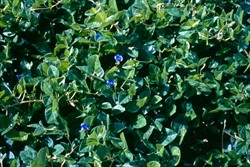
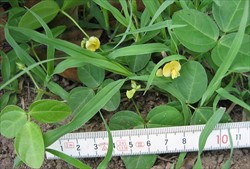
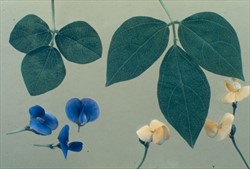
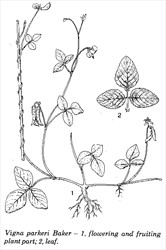
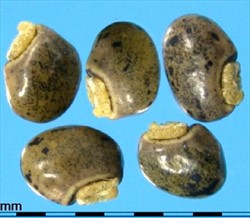
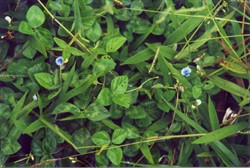
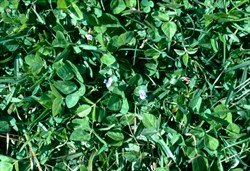
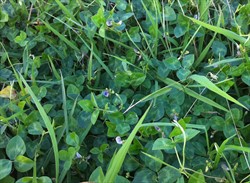
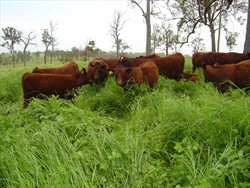 V. parkeri: twining up Chloris gayana, N NSW, Australia (cv. Shaw)
V. parkeri: twining up Chloris gayana, N NSW, Australia (cv. Shaw)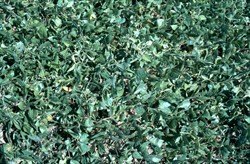 V. hosei: perennial twining or creeping herbs often forming a thick ground cover. South Johnstone, Qld, Australia
V. hosei: perennial twining or creeping herbs often forming a thick ground cover. South Johnstone, Qld, Australia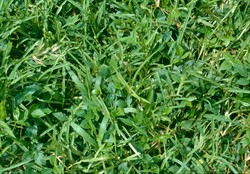 V. hosei with Stenotaphrum secundatum on Espiritu Santo, Vanuatu
V. hosei with Stenotaphrum secundatum on Espiritu Santo, Vanuatu



